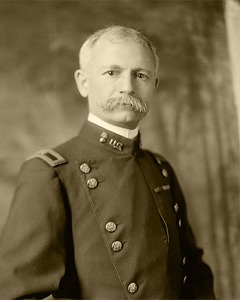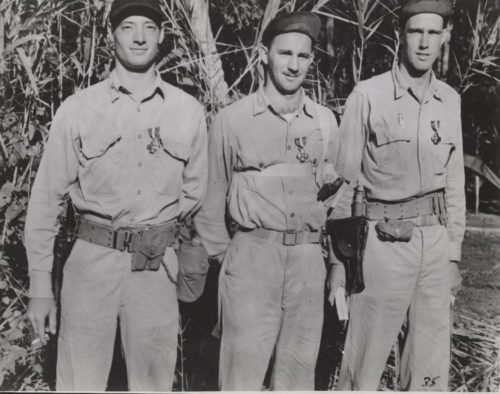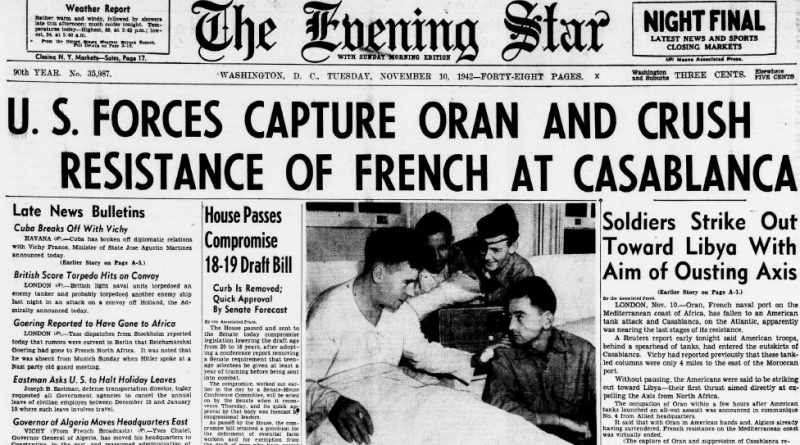World War II Chronicle: November 10, 1942
Click here for TODAY’S NEWSPAPER
Pictured on the front page is Pvt. Al Schmid, who famously held off a nighttime frontal assault by Col. Kiyonao Ichiki’s regiment as they attempted to recapture Guadalcanal’s Henderson Field. Pfc. John Rivers, Schmid, and Cpl. LeRoy Diamond guarded a section of the Tenaru River with their machinegun for Company H, 2nd Battalion, 1st Marines. All were awarded the Navy Cross (Rivers posthumously). Schmid’s story turns into the movie Pride of the Marines (1945)…
An AP correspondent speculates on page four that with U.S. forces now in North Africa, Nazi Germany will likely occupy all of France… An embedded correspondent tells of a late October engagement in the Solomons where Naval aviators and U.S. anti-aircraft gunners shot down more than 100 enemy planes in three hours (see page five)…
When the German U-boat U-94 comes under attack from a PBY Catalina and a Canadian convoy escort in the Caribbean, the crew surfaces and begins to scuttle their boat. A Royal Canadian lieutenant and petty officer (pictured on page three) board the ship and attempt to capture the Enigma machine and take the crew prisoner. They fight their way in, but find that the sub is already sinking. 26 prisoners, including skipper Oberleutnant zur See Otto Ites. U-94 had sunk 141,852 tons of shipping — 26 Allied vessels. Ites spends the remainder of the war at Camp Crossville (Tenn.), but his twin brother Rudolf is currently in U-boat training. Rudolf serves as a watch officer aboard U-709 before command school, then returns to his boat to lead her last war patrol.

Sports begins on page 16… Maj. Gen. William Crozier’s obituary is on page 23. Crozier graduated first in his class (1876) from West Point, during a time when many of the instructor cadre were Civil War veterans, like Superintendent Thomas G. Pitcher — a Union brigadier general. Crozier fought the Sioux and Braddock on the frontier before service in the Philippines and then the Boxer Rebellion. During the First World War he served on the Supreme War Council and worked together with Winston Churchill, Great Britain’s Munitions Minister, on how to best organize Allied munitions…
A dispatch from embedded war correspondents on page 31 details the fighting on Algiers… Marine aviators detail to the press how they have been faring so well against Japanese at Guadalcanal (see page 33). Maj. John Lucian Smith is skipper of Marine Fighter Squadron 223 (VMF-223) and leading scorer with 19 victories by campaign’s end. He receives the Medal of Honor for his actions during Guadalcanal. He leads Marine Aircraft Group 33 during the Korean War. Carl would finish the war with 18-1/2 victories, going on to become a test pilot before deploying to Vietnam, where he flew combat missions in jets and helicopters despite being a brigadier general. Lt. Col. Charles Mangrum is the commander — and last man standing (all other members were killed, hospitalized, or wounded) of Marine Scout Bombing Squadron 232 (VMSB-232). During the Korean War Mangrum leads Marine Aircraft Group 12, and later becomes Assistant Commandant of the Marine Corps…

The “Philippine Escape” story continues on page 39
Evening star. (Washington, D.C.), 10 November 1942. Chronicling America: Historic American Newspapers. Lib. of Congress.
https://chroniclingamerica.loc.gov/lccn/sn83045462/1942-11-10/ed-1/
